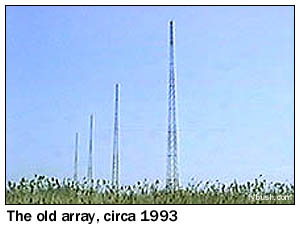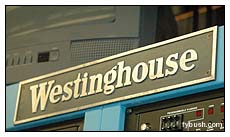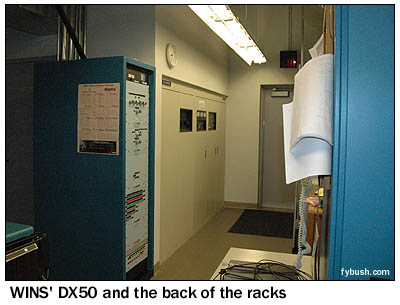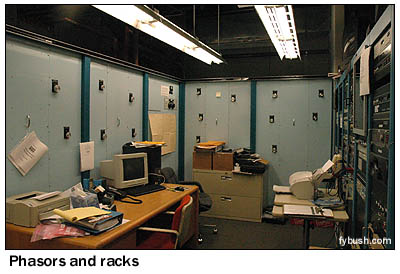
|
|

May 20, 2005
1010 WINS, Lyndhurst, N.J.
There's just nothing in the world quite like the forest of AM sites that dot the New Jersey Meadowlands, just across the Hudson River from Manhattan. Over the last decade or so, we've had the chance to visit many of them - at least from the outside. But it's always a particularly special experience to get the chance to see what's inside these sites - especially when their engineers have just finished spending lots of time and effort renovating.
Last week, we showed you all the work that the ABC engineers put into rebuilding the 1050 site in East Rutherford, now ESPN Radio's flagship WEPN. Next week, we'll go up north to Lodi to see the legendary WABC, just in time for the annual "WABC Rewound" broadcast on Memorial Day.
But this week, the focus is on a station that was doing top 40 long before WABC found its way into radio legend with the format: WINS (1010), transmitting from Polito Avenue in Lyndhurst.
WINS began its life as WGBS, the radio station of Gimbel Brothers Department Store, in October 1924. In 1932, WGBS was sold to William Randolph Hearst, who adopted the WINS calls to promote the news service he owned, International News Service. (That INS would later merge with United Press to create UPI, but that's another story.)
Back then, the station was a kilowatt daytimer on 1180, and I believe it was transmitting from a site a mile or so north of here, in Carlstadt, not far from the present-day Giants Stadium complex. In 1941, the NARBA dial shifts moved WINS to 1000 and landed it a power boost to 10,000 watts. Two years later, it moved one notch up the dial to 1010 and went full-time with 50,000 watts from the site in Lyndhurst that it's still using. (In the interim, it spent a little while operating from the former WHN 1010 facilities in Astoria, Queens.)
 Even
with 50,000 watts, the WINS of 1943 was still a far cry from
the enormous signals of its competitors down the dial. 1010 was
(and still is) a Canadian clear channel, and WINS had to protect
the signal of CFRB in Toronto. To do so, the station used four
very short self-supporting towers that produced a good signal
over the city, but threw very little signal out over New Jersey
or into the suburbs north of the city.
Even
with 50,000 watts, the WINS of 1943 was still a far cry from
the enormous signals of its competitors down the dial. 1010 was
(and still is) a Canadian clear channel, and WINS had to protect
the signal of CFRB in Toronto. To do so, the station used four
very short self-supporting towers that produced a good signal
over the city, but threw very little signal out over New Jersey
or into the suburbs north of the city.
(The image shown at left is, alas, the best one I have of that old array; when I saw it in 1993, I was shooting video and not stills, and it wasn't great video, either.)
Hearst sold WINS to Crosley Broadcasting in 1946, making the station a sister to WLW in Cincinnati (and indeed, WINS even simulcast much of WLW's programming, though nobody in New York had much interest in listening to Cincinnati-based programs.)
Seattle's J. Elroy McCaw (whose family would later make a fortune as cellular-telephone pioneers) bought WINS in 1953, and it wasn't much later that the station became one of the first big-city top 40 outlets, featuring jocks such as Alan Freed and Pete "Mad Daddy" Myers and breaking the ground for later, bigger successes by WHN, WABC and WMCA. WINS itself ended up being sold to Westinghouse in 1962, returning the company to the New York market almost 40 years after it transferred the original license to WJZ to RCA. (Irony alert: WJZ, of course, became WABC and drove WINS out of the top-40 format.)
 In
April 1965, Westinghouse took a huge leap with WINS, turning
the station into one of America's first all-news outlets. Though
greeted with much derision at first, the format proved to be
a huge success, regularly landing the station high atop the list
of the top-billing broadcasters in America.
In
April 1965, Westinghouse took a huge leap with WINS, turning
the station into one of America's first all-news outlets. Though
greeted with much derision at first, the format proved to be
a huge success, regularly landing the station high atop the list
of the top-billing broadcasters in America.
In the mid-nineties, the company began addressing the signal problems at WINS, entering into international negotiations aimed at allowing WINS and Toronto's CFRB to direct more signal at each other. In 1995, WINS demolished the four 1943 towers at Lyndhurst, temporarily operating with 10 kW non-directional from the WABC auxiliary tower in Lodi while building four new 410-foot towers in Lyndhurst. (CFRB also rebuilt its array in Mississauga, Ontario at the same time.)
The new array allowed WINS to let out some of its tight nulls over the New Jersey suburbs, especially at night, but the station's programming remained tightly focused on the New York City audience, especially after Westinghouse's acquisition of CBS made WINS a sister station to what was once its all-news competitor, WCBS (880), as well as sports giant WFAN (660).
(The new tall towers also provided a useful spot for an auxiliary antenna for WNEW-FM 102.7, which had by then become a Westinghouse sister station to WINS.)
 |
 |
So with all that history behind us, what do we find inside that modest concrete block building on Polito Avenue? After many years of wondering, your editor finally had the chance to go inside in February 2005, in a brief and impromptu late-night tour following a Society of Broadcast Engineers meeting at the WEPN site.
As you
walk in, WINS' old Harris MW50 transmitter sits immediately to
your left, and just beyond it are two auxiliary transmitters
for WNEW, an older Harris (which used to live at WNEW's main
site at the Empire State Building and still sports the "Where
Rock Lives" logo from better days at 102.7) and a newer
BE (which bears the "Blink" logo from some not-so-much-better
days at 102.7). There's a BE 10 kW backup for WINS there, too.
Behind the MW50 sits a room full of power-handling gear - and across from the MW50, we find the back of the racks that hold WINS' STL, processing and remote control gear.
The racks face into a "U"-shaped area, completed by the big Kintronics phasors (a smaller one for day use, a bigger one for night use) that were installed during the 1995 rebuild. And the whole "U" in turn faces WINS' main transmitter, a Harris DX50 that also dates from around that same era. (You can see the DX50 above; to the left of the DX50 is a rack of switching gear to handle pattern and transmitter switching, and to the left of that is the bathroom!)
Aside from a small office/workbench area that's up a half-flight of stairs at the rear of the building, that's about it for this compact site - except to note that the big "Westinghouse" plaque that used to adorn an older transmitter here (probably the classic Westinghouse 50HG that seems to have found its way into every Westinghouse AM station in the sixties) was salvaged and now adorns the processing racks. (That's the sign shown in the image above.) Nice to see some history being saved!
It's here - the 2005 Tower Site Calendar is now available at special clearance prices! Click here for ordering information!
- Previous Site of the Week: WEPN 1050, East Rutherford, N.J.
- Next Week: 77 WABC, Lodi, N.J.
- Site of the Week INDEX!
- How can you help support Site of the Week? Click here!
- Submit your suggestions for a future Site of the Week!
